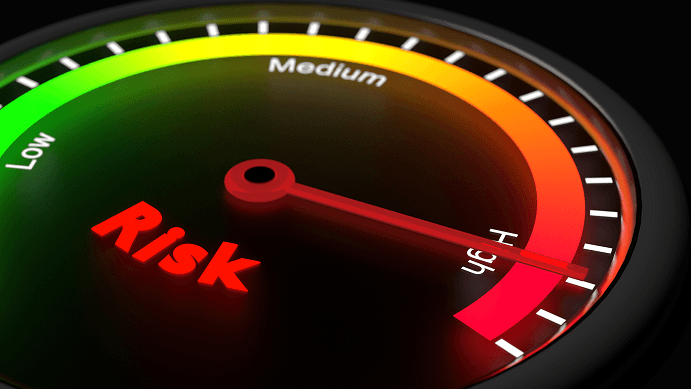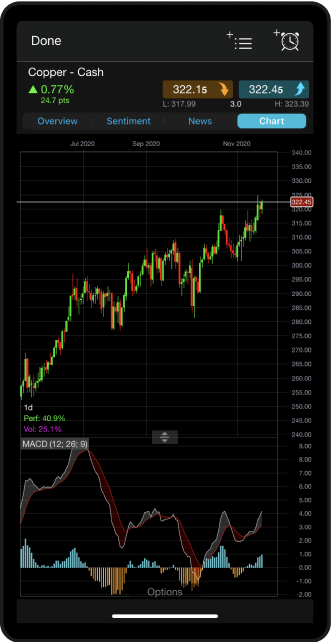Risks of CFD trading
Published on: 02/11/2021 | Modified on: 30/11/2022
As a new trader, it is important to understand the risks associated with CFD trading before you start trading with a live account.
Spread bets and CFDs are complex instruments and come with a high risk of losing money rapidly due to leverage. 70% of retail investor accounts lose money when spread betting and/or trading CFDs with this provider. You should consider whether you understand how spread bets, CFDs, OTC options or any of our other products work and whether you can afford to take the high risk of losing your money.
Published on: 02/11/2021 | Modified on: 30/11/2022
As a new trader, it is important to understand the risks associated with CFD trading before you start trading with a live account.

Leverage gives you exposure to the markets by depositing just a percentage of the full value of the trade you wish to place. This means that while you could make a potential profit if the market moves in your favour, you could just as easily make significant losses if the trade moves against you and you don't have adequate risk management in place. This is also known as margin trading.
For instance, if you place a CFD trade worth £1,000 and the margin rate for the applicable tier is 5%, you only need to fund 5% of the total value of the position, known as position margin. In this case, you only need to allocate £50 to open the trade.
If, however, the price of the instrument moves against you by 10%, you would lose £100 – double your initial stake in the CFD trade. This is because your exposure to the market (or your risk) is the same as if you had purchased £1,000 worth of physical shares. This means that any move in the market will have a greater effect on your capital than if you had purchased the same value of shares.
However, retail client accounts have negative balance protection, so your losses will be limited to the value of the funds in your account. Learn more about calculating CFD margins here.
Market volatility and rapid changes in price, which may arise outside normal business hours if you are trading international markets, can cause the balance of your account to change quickly. If you do not have sufficient funds in your account to cover these situations, there is a risk that your positions will be automatically closed by the platform if the balance of your account falls below the close-out level (as shown on the platform).
You should continuously monitor your account and deposit additional funds or close your positions (or a portion of your positions) so that the funds in your account cover the total margin requirement at all times. The information icon within the main account bar at the top of the CFD trading platform will detail all your account information, including the close-out percentage level.
If the current close-out percentage level is 50% and you have four trades open that each require £500 worth of position margin, your total position margin requirement will be £2,000. If your account revaluation amount then drops to less than 50% of the total margin requirement, in this case £1,000, some or all of the trades constituting this position may be closed out, potentially at a loss to you.
The account revaluation amount is the sum of your cash and any net unrealised profit or loss (as applicable), where net unrealised profit or loss is calculated using the level 1 mid-price.



Financial markets may fluctuate rapidly and the prices of our instruments will reflect this. Gapping is a risk that arises as a result of market volatility. Gapping occurs when the prices of our instruments suddenly shift from one level to another, without passing through the level in between.
There may not always be an opportunity for you to place a market order or for the platform to execute an order between the two price levels. One of the effects of this may be that stop-loss orders are executed at unfavourable prices, either higher or lower than you may have anticipated, depending on the direction of your trade.
You are able to limit the risk and impact of market volatility by applying an order boundary or guaranteed stop-loss order. Learn how to trade gaps in price charts.
Depending on the positions you hold, and how long you hold them for, you may incur CFD holding costs. These holding costs are applied to your account on a daily basis if you hold positions on certain instruments overnight past 5pm New York time. In some cases, particularly if you hold positions for a long time, the sum of these holding costs may exceed the amount of any profits, or they could significantly increase losses. It is important that you have sufficient funds in your account to cover your holding costs.
CFD trading carries a high level of risk to your capital compared to other kinds of investments, and prices could move rapidly against you. Therefore, CFD trading may not be appropriate for everyone and we recommend that you understand the risks, and seek independent professional advice if necessary, before deciding whether to start CFD trading. Read an overview to our CFD costs here.
FAQs
CFDs are a type of derivative product that allow traders to speculate on the price movements of a financial security without taking ownership or paying the full value upfront. Instead, you buy or sell a number of units, depending on whether you think the price will rise or fall. To learn how to trade CFDs, follow our CFD trading tutorial.
You can hold CFD trades for any duration between a few seconds to several months. However, you will be subject to overnight holding costs if carrying any positions over, which can be positive or negative depending on the size and direction of the position. Find out more about overnight CFD fees.
You can lose more money than you expected when trading CFDs, as losses are based on the full value of the position, rather than just the margin deposit. This is a risk that comes with trading on leverage. Learn how to combat the risks of CFDs using risk-management controls.
Whereas spread betting is tax-free in the UK*, CFD traders are required to pay capital gains tax, although both products are exempt from stamp duty. Read more on taxation: spread bets versus CFDs.
As CFDs are a derivative product and can be used to speculate on the price movements of securities, it’s not possible to trade them without leverage. However, leverage can offer benefits, such as the ability to magnify any profits made on successful positions (as well as magnifying losses). Learn how to trade with leverage carefully and efficiently.
CMC Markets is an execution-only service provider. The material (whether or not it states any opinions) is for general information purposes only, and does not take into account your personal circumstances or objectives. Nothing in this material is (or should be considered to be) financial, investment or other advice on which reliance should be placed. No opinion given in the material constitutes a recommendation by CMC Markets or the author that any particular investment, security, transaction or investment strategy is suitable for any specific person. The material has not been prepared in accordance with legal requirements designed to promote the independence of investment research. Although we are not specifically prevented from dealing before providing this material, we do not seek to take advantage of the material prior to its dissemination.